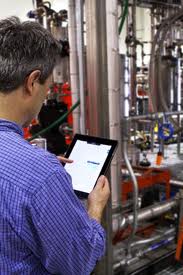 Mobile use among plant floor personnel is an interesting development since part of the push to adopt mobile technologies is from employees providing their own hardware. Plant floor personnel use of mobile devices for operations is accelerating regardless of whether plant managers have a mobile strategy in place or not. Historically, plant floor technology adoption varied depending upon the upfront investments required. High cost technologies can take decades for widespread adoption, but mobile technology has swept through the manufacturing industry swiftly. Due to low initial costs, manufacturers can realize the benefits of mobile adoption almost immediately, but they need to have a plan in place in order to realize quantifiable benefits.
Mobile use among plant floor personnel is an interesting development since part of the push to adopt mobile technologies is from employees providing their own hardware. Plant floor personnel use of mobile devices for operations is accelerating regardless of whether plant managers have a mobile strategy in place or not. Historically, plant floor technology adoption varied depending upon the upfront investments required. High cost technologies can take decades for widespread adoption, but mobile technology has swept through the manufacturing industry swiftly. Due to low initial costs, manufacturers can realize the benefits of mobile adoption almost immediately, but they need to have a plan in place in order to realize quantifiable benefits.
Mobile Benefits
A simple mobile notification can have a big effect. With the sound of a ding, an operator can glance at the phone to view all of the information they need to understand plant floor performance. A customized dashboard can monitor equipment and personnel. More importantly, their dashboard can clearly display a problem on the line. With a flick of a finger, an automatic audit explains the problem along with the protocol for corrective action. The operator makes a decision, a team is notified, electronic work instructions are delivered and digital checklists ensure protocols are followed. Even the operator-in-training can collaborate easily and quickly early in their learning curve.
How-to Go Mobile
With widespread adoption underway, it’s not hard to find mobile plant floor success stories. Plant managers can objectively evaluate successes by researching use cases from similar manufacturers. For quick and low cost mobile adoption, many manufacturers are opting for bring your own device solutions (BYOD). The downside of BYOD approaches is that they might lack control and security requirements necessary for IT approval. They also require multiple platform software developments so that the apps takes advantage of unique iOS and Android device capabilities, such as offline use in particular.
Mobile hardware deployments have costs that may be harder to justify for some manufacturers, but with the cost comes security, durability, consistency and control. A single device type means that there only needs to be one piece of software used. The device can be hardened for a rough plant environment and controlled just like other devices on the plant floor.
In order to launch a mobile workforce environment, some infrastructure changes may be required such as:
- Changes in wireless security (more localized security points vs. general plant)
- Increased bandwidth for wireless access and Internet or corporate cloud access
- Company controlled devices vs. personal devices to ensure personal apps do not create “security holes”
- Encrypted exchange of data for layered security.
Develop a Strategy
Due to the ease of use and adoption, hodgepodge approaches to mobile operations are becoming commonplace. However, this approach can put the plant in a security risk. Plant managers still have the opportunity to manage mobile operations so that they are optimized to meet goals and provide consistency throughout the plant, but they have to develop a strategy for success.



